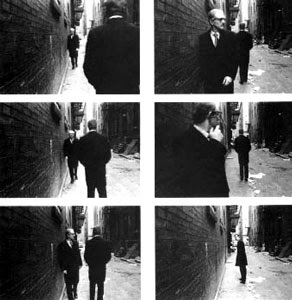Here are a few more photographers that are interesting and link in well with my project.
Donald Christie
I like the above images taken by Donald Christie because they are very 'photojournalism style' photos. They have been taken very quickly and 'in the moment' as the situation is happening before his eyes. I like the photo of the un-opened waterlily as it reminds me of the photo I took of the spoon and pan left in the kitchen sink, which I liked because the water looked mysterious and murky, similar to the water the lily is floating in.
Frank Lee
 |
| I love the amount of different patterns and shapes there are in this photo, the curves against the strong zig-zag lines. |
 |
| Again, the patterns and shapes are very interesting and are very contrasting, for instance the circular mirror against the straight wall. |
 |
| Love the perspective of this photo, it looks like a vortex that you might get sucked into! |
 |
| I love the fact that this image has alot of symmetry, for instance the two men are standing face to face in the centre of the photo, without realising. |
|
|
I love love love Frank Lee's photos, especially the group of photos taken in the London underground, some of which I have posted above from his website. All of them are black&white which enhances the contrast and tone in each image, especially because the underground is full of different patterns, shapes, levels and symmetry. The lighting is also very particular in each image, adding to the symmetry and shape. For instance the first photo I have posted of Frank Lee's work above, has very soft ceiling lighting, which contrasts with the strong, robust shapes of the walls and the stairs.
Duane Michals
I really like Duane Michals' photo sequences, because they are documenting certain scenes, yet are set-up too, so are not photos necessarily 'in the moment.' However they document an episode of time frame by frame, rather than just in one photo, making them fun and interesting to look at because you see the scene unravelling before your eyes.
Henri Cartier-Bresson
French photographer famous for his street photography.
Above is a great shot by famous photographer Henri Cartier-Bresson. It's a street photo which was taken just at the right time, which couldn't have been easily photographed again. There's an element of 'luck' in documentary and street photography because if a photographer is a second late at taking a shot, it might be too late, and no longer the perfect shot.
That's why it's important for me to have my camera on me as much as possible to take photos of things which might not still be there a day, or even a couple of minutes or seconds later.
Arthur Fellig (Weegee)
 |
| Lovers in the movies. |
|
Above is a great 'street' photo taken in the cinema by photographer Arthur Fellig. This photo shows elements of surveillance and documenting because the couple appear unaware that the photo was being taken.

















































